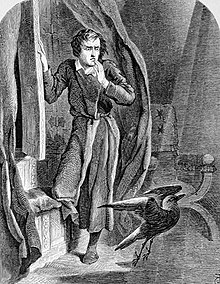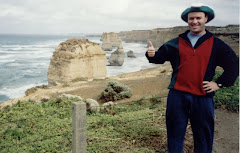Jokes in English
sábado, 1 de dezembro de 2012
Songs of the Week
Green Day - Time Of Your Life
Green Day - Macy's Day Parade
THE SMASHING PUMPKINS - TODAY
THE SMASHING PUMPKINS - 1979
sexta-feira, 30 de novembro de 2012
Book of the Week
Christmas Books
For a collection of great Christmas stories, click on the following links:
http://www.gutenberg.org/files/13213/13213-h/13213-h.htm
http://www.gutenberg.org/files/5061/5061-h/5061-h.htm
Tips on Pronunciation
How to Improve Your English Pronunciation
by Melanie on July 12, 2012

(Photo by Leo Reynolds)
1) Practice for at least 30 minutes every day
There is no way around it: the only way your pronunciation will improve is if you practice, practice, practice! Your pronunciation will not magically improve just because you’re speaking English. The sounds of English may be very different from the sounds in your language. It may be difficult and even uncomfortable for your mouth to make some of the sounds in English.You need to practice with a purpose. Practice the sounds of English until they feel as natural and comfortable as the sounds of your language. It won’t happen overnight, but gradually your pronunciation will improve.
2) Decide what kind of accent you would like to speak with
There are many different kinds of English accents. The two most common are British and American. There are many different accents even within British or American pronunciation, but most learning materials will help you learn either a standard British accent or a standard American accent.American pronunciation and British pronunciation are completely different. The consonant sounds are the same (except for the letter ‘t’ and an ‘r’ after a vowel), but the vowel sounds are very different. The British accent has more vowel sounds, and some vowel letters are pronounced differently.
3) Learn the IPA and the individual sounds of English
The International Phonetic Alphabet (IPA) is a collection of symbols that represent the different sounds of a language. When you know the all the sounds of English and the symbols that represent those sounds, you will be able to pronounce any word in English.American Pronunciation:
The Merriam-Webster’s Learner’s Dictionary Pronunciation Guide
Antimoon IPA chart
Rachel’s English
British Pronunciation:
BBC Learning English
Interactive IPA Chart
4) When you learn a new word, learn how to pronounce it correctly
The longer you say a word incorrectly, the harder it becomes to learn to say it correctly. You’ve developed a bad habit, and it takes a long time to break a bad habit! This is why it is so important to learn the IPA and use dictionaries specifically for English learners.For example, let’s say you see a new word when you’re reading a book: permeate. How do you pronounce this word? Let’s check two of the online dictionaries specifically for English learners:
MW Learner’s Dictionary
Cambridge
Both of these dictionaries show you the IPA/phonetic transcription of the word (including which syllable you must stress): /ˈpɚmiˌeɪt/
You can also click on the red or blue speaker icon to hear someone say the word.
5) Watch YouTube pronunciation videos
American accent:Teacher Melanie
JenniferESL
Lisa Mojsin @ Accurage English
Rachel’s English
Pronuncian/Seattle Learning Academy
Eva Easton
British accent:
The Phone Voice
VirtuAule
6) Try to imitate spoken English
To ‘imitate’ means to copy someone/something, to do something the same way, or to do the same things as someone else. Do you really like the way someone speaks English? Try to copy the way they speak.This is a great activity to try: Close your eyes while you’re listening to something in English (podcasts, songs, TV shows, movies, etc.). Listen carefully to what the speaker is saying and try to make the same sounds. Choose a word or sentence, and listen to it many times.
Here are some resources that are useful for this:
English Teacher Melanie podcast
ESLPod podcast
Coach Shane’s Daily Dictation
Try to imitate the sounds that native speakers make.
7) Practice HEARING the sounds of English
Before you listen to an English podcast, song, etc. read the words first. Highlight, circle, or underline the sound you want to work on. For example, if you have trouble with the /I/ sound, highlight all the words that you think have the /I/ sound. Read the passage out loud to yourself, focusing on the words with /I/. Listen to the podcast (or song, etc.). Can you hear the /I/ sound? Practice the sound by trying to imitate what the speaker is saying.8) Record yourself
It’s important to hear what you sound like speaking English so you know what you need to improve! You can compare what you sound like to what you want to sound like. For example, you record yourself reading a sentence from one of my podcasts. Then, listen to me say the same sentence and compare your pronunciation.If you don’t have any recording software on your computer (like Windows Sound Recorder or GarageBand on Macs), you can use a web-based audio recorder:
audioboo
Vocaroo
SoundCloud
You may also be able to find a cheap digital voice recorder at your local electronics store.
9) Pronunciation Books
Here are the two books that I use to understand and teach American pronunciation. Check your local library for these books. If you attend a private language school, ask if it has these books. If you live in a large city, look for these books at an English bookstore. Buy these books online.Mastering the American Accent – Lisa Mojsin
| This is quite possibly the greatest book on American pronunciation for both teachers and advanced learners! It does not go through each and every sound (like the book below does). It focuses on the things that will help a non-native speaker speak with a standard American accent (like the kind you hear on CNN!): difficult consonant sounds, linking, syllable and word stress, intonation, and the difference between casual and formal speech. At the back of the book there is a ‘native language guide’ that explains what different nationalities (Chinese, Spanish, Russian, etc.) need to focus on. The book also includes 4 CDs so that the learner can listen to someone speaking almost every exercise. |
English Pronunciation Made Simple – Paulette Dale and Lillian Poms
| This book explains each individual sound in standard American English, as well as all the other elements of spoken English: rhythm, stress, intonation, consonant clusters, plurals, contractions, past tense verbs, etc. This is a great book for teachers to use as a classroom textbook as there are a lot of exercises teachers will find useful in the classroom. It is better for teachers than for students, as the 2 included CDs don’t say all the words and exercises. This book also helps to learn the IPA as it uses the IPA symbols to help explain American English pronunciation. |
10) Have your pronunciation professionally evaluated
When your pronunciation is evaluated by a teacher, he/she can tell you exactly what you are doing right and what you are doing wrong. He/She can tell you exactly what sounds you need to work on to sound more like a native speaker.Use the search terms “English pronunciation assessment” or “English pronunciation evaluation” to find teachers online.
Source: http://www.englishteachermelanie.com/study-tip-how-to-improve-your-english-pronunciation/
Proficiency Tests
Proficiency test
A proficiency test measures a learner's level of language. It can be
compared with an achievement test, which evaluates a learner's
understanding of specific material, a diagnostic test, which identify
areas to work on, and a prognostic test, which tries to predict a
learner's ability to complete a course or take an exam. Proficiency
tests are uncommon within the classroom but very frequent as the end aim
(and motivation) of language learning.
Example
IELTS and TOEFL are examples of proficiency tests.
To do some sample tests, click on the links below:
http://www.transparent.com/learn-english/proficiency-test.html
http://www.ets.org/s/proficiencyprofile/pdf/sampleques.pdf
http://www.examenglish.com/cpe/index.php
http://www.sheridancollege.ca/Admissions/Explore/Programs/Applying%20to%20Sheridan/Assessment%20Centres/Assessment-Test%20Details/~/media/WF_02_OTR_002/english%20proficiency%20test%20sample.ashx
Special Recipe for Christmas
Holiday Brunch Casserole
Ingredients
- 4 cups frozen shredded hash brown potatoes
- 1 pound bulk pork sausage, cooked and drained
- 1/2 pound bacon strips, cooked and crumbled
- 1 medium green pepper, chopped
- 2 cups (8 ounces) shredded cheddar cheese, divided
- 1 green onion, chopped
- 1 cup reduced-fat biscuit/baking mix
- 1/2 teaspoon salt
- 4 eggs
- 3 cups 2% milk
Directions
- In a large bowl, combine the hash browns, sausage, bacon, green pepper, 1 cup cheese and onion. Transfer to a greased 13-in. x 9-in. baking dish.
- In another bowl, whisk the biscuit mix, salt, eggs and milk; pour over the top. Sprinkle with remaining cheese. Cover and refrigerate overnight.
- Remove from the refrigerator 30 minutes before baking. Bake, uncovered, at 375° for 30-35 minutes or a knife inserted near the center comes out clean. Let stand for 10 minutes before cutting. Yield: 12 servings.
sábado, 25 de agosto de 2012
Jokes in English - 24
A student is talking to his teacher.
Student: "Would you punish me for something I didn`t do?"
Teacher:" Of course not."
Student: "Good, because I haven't done my homework."
http://www.manythings.org/jokes/9985.html
A: Why are you late?
B: There was a man who lost a hundred dollar bill.
A: That's nice. Were you helping him look for it?
B: No, I was standing on it.
http://www.manythings.org/jokes/9992.html
Patient: "This hospital is no good. They treat us like dogs."
Doctor: "You know that's not true. Now roll over."
Student: "Would you punish me for something I didn`t do?"
Teacher:" Of course not."
Student: "Good, because I haven't done my homework."
http://www.manythings.org/jokes/9985.html
A: Why are you late?
B: There was a man who lost a hundred dollar bill.
A: That's nice. Were you helping him look for it?
B: No, I was standing on it.
http://www.manythings.org/jokes/9992.html
Patient: "This hospital is no good. They treat us like dogs."
Doctor: "You know that's not true. Now roll over."
Book of the Week - Werewolf
Werewolf
A werewolf, also known as a lycanthrope (from the Greek λυκάνθρωπος: λύκος, lukos, "wolf", and ἄνθρωπος, anthrōpos, "man"), is a mythological or folkloric human with the ability to shapeshift into a wolf or an anthropomorphic wolf-like creature, either purposely or after being placed under a curse
and/or lycanthropic affliction via a bite or scratch from a werewolf,
or some other means. This transformation is often associated with the
appearance of the full moon, as popularly noted by the medieval chronicler Gervase of Tilbury, and perhaps in earlier times among the ancient Greeks through the writings of Petronius.
In addition to the natural characteristics inherent to both wolves
and humans, werewolves are often attributed strength and speed far
beyond those of wolves or men. The werewolf is generally held as a European
character, although its lore spread through the world in later times.
Shape-shifters, similar to werewolves, are common in tales from all over
the world, most notably amongst the Native Americans, though most of them involve animal forms other than wolves.
Werewolves are a frequent subject of modern fiction,
although fictional werewolves have been attributed traits distinct from
those of original folklore. For example, the ideas that werewolves are
only vulnerable to silver bullets
or pierced by silver weapons, or that they can cause others to become
werewolves by biting or wounding them derive from works of modern
fiction. Werewolves continue to endure in modern culture and fiction,
with books, films and television shows cementing the werewolf's stance
as a dominant figure in horror.
To read the book in PDF, click on the following site:
History of English
History of the English language
From Wikipedia, the free encyclopedia
English is a West Germanic language that originated from the Anglo-Frisian dialects brought to Britain by Germanic invaders and/or settlers from various parts of what is now northwest Germany and the Netherlands. Initially, Old English was a diverse group of dialects, reflecting the varied origins of the Anglo-Saxon kingdoms of Britain. One of these dialects, Late West Saxon, eventually came to dominate.
The English language underwent extensive change in the Middle Ages. Written Old English of AD 1000 is similar in vocabulary and grammar to other old Germanic languages such as Old High German and Old Norse,
and completely unintelligible to modern speakers, while the modern
language is already largely recognisable in written Middle English of AD
1400. The transformation was caused by two further waves of invasion:
the first by speakers of the Scandinavian branch of the Germanic language family, who conquered and colonized parts of Britain in the 8th and 9th centuries; the second by the Normans in the 11th century, who spoke Old Norman and ultimately developed an English variety of this called Anglo-Norman. A large proportion of the modern English vocabulary comes directly from Anglo-Norman.
Close contact with the Scandinavians resulted in a significant grammatical simplification and lexical enrichment of the Anglo-Frisian core of English. However, these changes had not reached South West England
by the 9th century AD, where Old English was developed into a
full-fledged literary language. The Norman invasion occurred in 1066,
and when literary English rose anew in the 13th century, it was based on
the speech of London, much closer to the centre of Scandinavian settlement. Technical and cultural vocabulary was largely derived from Old Norman, with particularly heavy influence in the church, the courts, and government. With the coming of the Renaissance, as with most other developing European languages such as German and Dutch, Latin and Ancient Greek supplanted Norman and French as the main source of new words. Thus, English developed into very much a "borrowing" language with an enormously disparate vocabulary.
For further information on the topic, visit the following websites:
http://en.wikipedia.org/wiki/History_of_the_English_language
http://www.englishclub.com/english-language-history.htm
http://www.ielanguages.com/enghist.html
Grammar Tips
Commas and semi-colons. If the rules you learned about commas and
semi-colons don't mean much
to you, forget them and try this: Read one of your sentences aloud and see where you would
naturally pause, where you would draw a breath. If it's a short pause, like that just was, you
probably need a comma. If it's a longer pause, but not quite a full stop (for which you'd need a
period), you probably need a semi-colon; remember that whatever follows a semi-colon must be able
to stand on its own, as a full sentence, like this one.
If you don't want your reader to pause, there shouldn't be a comma, there, because as, this
demonstrates it's very difficult to figure, out, what you're saying when your punctuation, makes the
sentence unreadable.
Your sentences shouldn't leave your reader hyperventilating from the constant shallow breaths that
over-punctuation requires. Nor should they be gasping for breath at the end of a long, unpunctuated
sentence. (Consider yourself responsible for your readers' cardiovascular health.)
Check your dashes and hyphens. When you're setting off a clause—this
one is a good example—use
the longer dash, called an m-dash. (You can indicate this dash with two hyphens—like this—if you
don't have an m-dash function on your computer.) Be sure that the parts of the sentence that precede
and follow the dashes would make sense even if you removed the dashes and the words they bracket.
(In the example above, the sentence is readable with or without the clause inside the dashes.)
You can also use the m-dash in place of a colon if you want to emphasize more dramatically the words
that follow: "The mantlepiece was lined with photographs of people she loved—her mother, her
grandmother, a favorite aunt." Or you can use it to add a surprising element into a sentence: "Her
family's photographs were displayed on the mantlepiece; there were pictures of parents, grandparents,
and siblings—and of Muffin, a Yorkshire terrier." Whereas the m-dash is used to set off parts of a
sentence, hyphens are used to join words together: broken-hearted, two-thirds, sister-in-law.
Always identify abbreviations before you use them, unless you feel reasonably confident that
the average intelligent reader would be able to identify the
acronym—like when the acronym is
more commonly used than the words it stands for. (It would be odd to write out all the words for ESP,
NATO, CEO, or AIDS.) Keep in mind the audience for the particular essay you're writing, though;
readers who are specialists in a particular discipline may not want or need to have terms spelled out for
them.
Try to avoid split infinitives. This is no longer a hard and fast
rule, and occasionally keeping an
infinitive together in a sentence can introduce more awkwardness than the split, but usually the split is
ungraceful. (Imagine: To be or to not be.)
Make sure all your referents are clear. When you say "This theory" or
"that point" or, simply,
"it," is it clear which theory or point you're referring to? When you use "he" or "she" or "these
critics," will your reader have to pause to figure out who all these people are?
There's more to say about this. We often throw in a "this" when
we're not entirely sure exactly
what we want to draw our readers' attention to, especially when we're making a complex argument
with many different elements. Sometimes vagueness in our language can be a symptom of muddled
thinking. So ask yourself, what does this "this" refer to? What words would I replace it with? If you're
not easily able to answer, you need to go back and work out your ideas in that section. (Readers will
never understand what you mean when you don't know yourself. When you notice vague referents, or
other apparently minor problems, take the opportunity to ask yourself if there might be any larger
problem lurking beneath your surface error.)
Never use "that" when you're referring to a person: "The first man
that
walked on the moon."
"The author that she was referring to." These are people, not objects—it's insulting to call them "that."
Use who or whom: "The first man who walked on the moon." "The author to whom she was
referring." Are you using "that" because you're shaky on the who/whom thing? See below. (And while
you're at it, consider whether you're twisting your sentences around to avoid any other grammatical
points you're uncertain of. If so, take control! Liberate yourself! Learn the rules once and for all so
you can write freely, instead of skulking around trying not to break the rules—or breaking them without
realizing it. Try starting a text file in which you list the rules you tend to forget, and keep it open when
you write. You can look rules up in any style manual, or come to the Writing Center.)
Who is what doing what to whom? That's the question you
need to ask yourself if you're uncertain
which word to use. The one that does the action (the subject) is
who. The one that gets something done
to it (the object) is whom.
Avoid passive voice. It tends to sap energy and power from your prose.
It's usually better to say
"Einstein's theory" than "the theory that was formulated by Einstein."
Italics and underlines. You can use one or the other but never
both. They mean the same thing—underlining used to be a copy-editing mark to tell printers to set certain words in italic type.
Underlining italics meant the editor wanted the words taken out of italics. So underlining your already-
italicized phrase is, in effect, like using a double negative.
Be sure all of your sentences have parallel construction. This
sentence doesn't have it: "Re-
reading my first draft, I notice it's trite, repetitive, and with no thesis." This sentence does: "Re-
reading my first draft, I notice that it's trite and repetitive, and that it has no thesis." Or you could say:
"Re-reading my first draft, I notice it's trite, repetitive, and lacking in a thesis." In the two examples
with parallel construction, you could take out any of the words in the list and still have the sentence
make sense.
Copyright 1999, Kim Cooper, for the Writing Center at Harvard University
For some exercises on the topcis above, visit the following websites:
Recipe of the Week - Pasta Primavera
Pasta Primavera
Ingredients
- Kosher salt
- 12 ounces fusilli or other corkscrew pasta
- 1/2 pound sugar snap peas, halved lengthwise, or broccoli florets (or a combination)
- 2 carrots, shredded
- 1 yellow bell pepper, cut into thin strips
- 1/4 cup extra-virgin olive oil, plus more for drizzling
- 4 cloves garlic, thinly sliced
- 1 pint cherry tomatoes, halved
- 1/4 to 1/2 teaspoon red pepper flakes
- 1/2 cup roughly chopped fresh mint
- 1/2 cup grated parmesan cheese
- 4 ounces goat cheese, crumbled
Directions
Bring a large pot of salted water to a boil.
Add the fusilli and cook as the label directs. Add the sugar snap peas
and/or broccoli, carrots and bell pepper to the boiling water during the
last 2 minutes of cooking. Reserve 1/2 cup cooking water, then drain
the pasta and vegetables and return to the pot.
Meanwhile, heat the olive oil in a large skillet over medium heat.
Add the garlic and cook until just golden, about 30 seconds. Add the
tomatoes, red pepper flakes and 1 teaspoon salt; cook until the tomatoes
begin to wilt, about 2 minutes. Stir in 1/4 cup of the reserved cooking
water. Pour the tomato mixture over the pasta and vegetables. Add the
mint, parmesan and half the goat cheese and toss to combine. Season with salt.
Divide the pasta among bowls. Top with the remaining goat cheese and drizzle with olive oil.
Per serving: Calories 638; Fat 27 g (Saturated 10 g); Cholesterol
33 mg; Sodium 841 mg; Carbohydrate 77 g; Fiber 7 g; Protein 24 g
ACTIVE: 30 min l TOTAL: 30 min l SERVES: 4
domingo, 8 de julho de 2012
Recipe of the Week - Shepherd's Pie
Shepherd's Pie
A typical British treat.
Ingredients
- 1 tbsp sunflower oil
- 1 large onion , chopped
- 2-3 medium carrots , chopped
- 500g pack minced lamb
- 2 tbsp tomato purée
- large splash Worcestershire sauce
- 500ml beef stock
- 900g potatoes , cut into chunks
- 85g butter
- 3 tbsp milk
- Heat the oil in a medium saucepan, then soften the onion and carrots for a few mins. When soft, turn up the heat, crumble in the lamb and brown, tipping off any excess fat. Add the tomato purée and Worcestershire sauce, then fry for a few mins. Pour over the stock, bring to a simmer, then cover and cook for 40 mins, uncovering halfway.
- Meanwhile, heat the oven to 180C/ fan 160C/ gas 4, then make the mash. Boil the potatoes in salted water for 10-15 mins until tender. Drain, then mash with the butter and milk.
- Put the mince into an ovenproof dish, top with the mash and ruffle with a fork. The pie can now be chilled and frozen for up to a month. Bake for 20-25 mins until the top is starting to colour and the mince is bubbling through at the edges. (To bake from frozen, cook at 160C/fan 140C/gas 3 for 1 hr-1 hr 20 mins until piping hot in the centre. Flash under the grill to brown, if you like.) Leave to stand for 5 mins before serving.
For more British dishes, visit:
http://www.bbcgoodfood.com/content/recipes/cuisines/british/ sábado, 30 de junho de 2012
Book of the Week - Little Red Ridding Hood
Little Red Riding Hood, also known as Little Red Cap, is a European fairy tale about a young girl and a Big Bad Wolf. The story has been changed considerably in its history and subject to numerous modern adaptations and readings. The story was first published by Charles Perrault in Histoires ou contes du temps passé in 1697.
To read a PDF version of this book along with some other children's stories, click on the link below:
http://www.gutenberg.org/files/11592/11592-h/11592-h.htm
To watch some other classic stories, go to the link:
http://www.youtube.com/watch?v=o2btbpvezs4&feature=relmfu
Jokes in English - 23
Q: Can a kangaroo jump higher than the Empire State Building?
A: Yes, because the Empire State Building can't jump!
A teacher is talking to a student.
Teacher: Did your father help your with your homework?
Student: No, he did it all by himself.
To listen to this joke, click on the link below:
http://www.manythings.org/jokes/9963.html
A: Yes, because the Empire State Building can't jump!
A teacher is talking to a student.
Teacher: Did your father help your with your homework?
Student: No, he did it all by himself.
To listen to this joke, click on the link below:
http://www.manythings.org/jokes/9963.html
domingo, 17 de junho de 2012
Tips for Successful Job Interview
INTERVIEW QUESTIONS
Preparation for an interview is essential.
The list of questions below is designed to serve as a guide so that you are not taken by surprise!.
http://esl.about.com/od/businessspeakingskills/a/job_interview.htm
http://www.englishlink.com/en-us/free-english-tools/prepare-job-interview.aspx
Preparation for an interview is essential.
The list of questions below is designed to serve as a guide so that you are not taken by surprise!.
| 1 | Tell me about yourself. | ||
| 2 | How would you describe yourself? (character/personality) | ||
| 3 | What are your strengths/weaknesses? | ||
| 4 | Are you married? Single? Do you have a partner? | ||
| 5 |
What do you do in your free time? What are your hobbies? / Do you have any hobbies? |
||
| 6 |
Why are you interested in working for
our company? Why do you want to work for this company? |
||
| 7 | What type of position do you think you are suited for / would suit you? | ||
| 8 | How would you describe the position we have to offer? | ||
| 9 | What aspects of the position are you most / least interested in? | ||
| 10 | What would you like to find in this job that you didn't have in your previous job? | ||
| 11 | How do you think you could develop
the position? What would be your strategy to develop the position? |
||
| 12 |
What have you got to offer us? What could you contribute to our company? |
||
| 13 | Why do you want to leave your present
job? Why do you want to change jobs? |
||
| 14 | What were you responsible for? What did your job involve? |
||
| 15 | What do you think you gained by working in your last job? | ||
| 16 | What do you think of your (last) boss? | ||
| 17 | What are your salary requirements? How much would you hope to earn in this position? How much do you think you should be offered for this position? What salary would you expect (to be offered) for this position? |
||
| 18 | Have you received any offers of a job? | ||
| 19 |
Why have you had to look for a job for so
long? Why have you been looking for a job for so long? Why did it take you so long to find a new job? |
||
| 20 | How do you feel about your future in the profession? | ||
| 21 |
Have you had any failures? / What failures
have you had? Have you had any negative experiences? |
||
| 22 | What sort of obstacles have you come across/encountered in your work? | ||
| 23 | If you had to recruit colleagues, what qualities would you look for? | ||
| 24 |
Would you be willing to relocate/to move to
another part of the country/ to work abroad? Did you have to travel abroad in your last job? |
||
| 25 | Don't you think you have too much experience/you are over-qualified for this job? | ||
| 26 |
How long do you think you would stay with
us? If we offered you the job, how long would you expect to stay with us? |
||
| 27 |
Which do you prefer : to work alone or in a
team? Do you prefer working alone or with other people as part of a team? |
||
| 28 |
Do you know how to manage a team? Are you capable of leading a team? Do you think you have the ability to be a team leader? |
||
| 29 |
Why should I recruit you? How could you persuade me to recruit you? |
||
| 30 | Do you have any comments to make, or questions to ask? |
For more tips visit the following websites:
http://esl.about.com/library/weekly/aa120797.htmhttp://esl.about.com/od/businessspeakingskills/a/job_interview.htm
http://www.englishlink.com/en-us/free-english-tools/prepare-job-interview.aspx
Recipe of the Week - Special for the 4th of July
All-American Bacon Cheeseburgers Recipe
Ingredients
- 2 tablespoons finely chopped onion
- 2 tablespoons ketchup
- 1 garlic clove, minced
- 1 teaspoon sugar
- 1 teaspoon Worcestershire sauce
- 1 teaspoon steak sauce
- 1/4 teaspoon cider vinegar
- 1 pound ground beef
- 4 slices sharp cheddar cheese
- 4 hamburger buns, split and toasted
- 8 cooked bacon strips
- Optional toppings: lettuce leaves and tomato, onion and pickle slices
Directions
- In a large bowl, combine the first seven ingredients. Crumble beef over mixture and mix well. Shape into four patties.
- Grill burgers, covered, over medium heat or
broil 3 in. from the heat for 4-7 minutes on each side or until a
thermometer reads 160° and juices run clear. Top with cheese. Grill 1
minute longer or until cheese is melted. Serve on buns with bacon and
toppings of your choice. Yield: 4 servings.
Nutritional Facts
1 burger (calculated without optional toppings) equals 472 calories, 25
g fat (10 g saturated fat), 98 mg cholesterol, 947 mg sodium, 27 g
carbohydrate, 1 g fiber, 33 g protein.
Nutritional Facts
1 burger (calculated without optional toppings) equals 472 calories, 25
g fat (10 g saturated fat), 98 mg cholesterol, 947 mg sodium, 27 g
carbohydrate, 1 g fiber, 33 g protein.
sexta-feira, 4 de maio de 2012
Book of the Week - The Raven
"The Raven" is a narrative poem by American writer Edgar Allan Poe. First published in January 1845, the poem is often noted for its musicality, stylized language, and supernatural atmosphere. It tells of a talking raven's mysterious visit to a distraught lover, tracing the man's slow descent into madness. The lover, often identified as being a student, is lamenting the loss of his love, Lenore. Sitting on a bust of Pallas, the raven seems to further instigate his distress with its constant repetition of the word "Nevermore". The poem makes use of a number of folk and classical references.
To read the poem in a PDF file, go to the link below:
http://www.ibiblio.org/ebooks/Poe/Raven.pdf
If you want to do some interpretation of it with your students, here are some exercises:
http://www.readwritethink.org/files/resources/lesson_images/lesson411/RavenWorksheet.pdf
To listen to it, go to:
http://librivox.org/the-raven-by-edgar-allan-poe/
My Trips 11 - Luxor
Luxor - Egypt
Most people who go to Egypt do so to visit the Pyramids, in Giza; however, they would be just the tip of the iceberg, as this country has so much more to offer to its visitors. 700km south of Cairo, Luxor is a blend of town by the Nile River and a huge variety of ancient sites and catacumbs, among many, the famous Tutankamon lies in the Valley of the Kings, which was found unspoiled. The Karnak Temple makes it certainly worth the train trip, which may last between 9 and 10 hours.
Karnak Temple
Karnak Temple Entrance
Karnak Temple Pool
Colossus of Memnon
Ramesseum
Assinar:
Postagens (Atom)



























